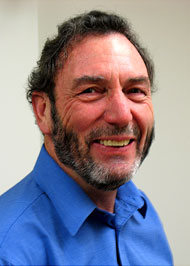Michael J. Rovetto, PhD
Research Interests
Cellular and molecular aspects of cardiac function
Research Description
Rovetto's current research is aimed at gaining a greater understanding of the control of energy production and metabolism in normal and diseased hearts. During myocardial ischemia, purines are lost from the heart. The amount lost during ischemia is directly related to recovery of mechanical function upon restoration of blood flow to the heart. If purine loss is prevented, or if the total purine content is restored to pre-ischemic values, heart function can be enhanced. However, to restore purine content requires days under normal conditions. By increasing the extracellular concentrations of purines to very high values, restoration can be reduced to several hours. However, these high purine concentrations interfere with heart function. Therefore, one important question is how to more quickly restore cardiac purine level without increasing extracellular concentration to values which interfere with normal heart function. Isolated perfused organs, cell cultures and cell fragments are used in studying ways of saving the injured heart.
Rovetto also studies the purine nucleoside adenosine (ADO), which is intimately involved in a number of metabolic and regulatory processes. In the heart, its transport into cells is essential for synthesis of adenosine monophosphate (AMP). Its transport out is essential for communication between cells to regulate blood flow and control nervous activity. A number of questions currently are being asked of this transport mechanism. Is a single protein involved in transport in both directions across the cell membranes or are there two distinct proteins? Is transport out coupled to AMP hydrolysis or is ADO formed in the cell and then transported from the cell? How are transport processes into and out of the heart cells controlled? The approaches to these questions involve use of molecular and biochemical techniques as well as studies of tissue and cell physiologic function.
Professional Background
- Received PhD in physiology, University of Virginia.
- Completed postdoctoral studies at Hershey Medical Center.
- Elected member/fellow of several societies including The American Physiological Society, The Biophysical Society and The American Heart Association.
- Served on several National Institutes of Health study sections and was a member of the Cardiovascular and Renal Study Section.
- Past reviewer on the Veterans Administration Cardiovascular Merit Review Board.
- Served on the editorial boards of The American Journal of Physiology and Circulation Research.
- Past member of the editorial board of The International Journal of Purine and Pyrimidine Research.
- Previous NIH Research Career Development Awardee for research in heart metabolism.
- Received continuous NIH grants since 1975.
Selected Publications
- Ford, D.A. and M.J. Rovetto. Rat cardiac myocyte adenosine transport and metabolism. Am. J. Physiol. 252:H54-H63, 1987.
- Sunnergren, K.P. and M.J. Rovetto. Myocyte and endothelial cell injury with ischemia reperfusion in isolated rat hearts. Am. J. Physiol. 252:H1211- H1217, 1987.
- Hale, C.C., S.B. Kleiboeker, C.G. Carlton, M.J. Rovetto, C.Y. Jung and H.D. Kim. Eviden ce for high molecul ar weight Na-Ca exchan ge in cardiac sarcole mmal vesicles. J. Membr. Biol. 106:21 1-218, 1988.
- Hale, C.C., C.G. Carlton and M.J. Rovetto. Adenosine uptake in cardiac sarcolemmal vesicles. Int. J. Purine Pyrimidine Research 1:1-6, 1990.
- Dale, W.E., C.C. Hale, H.D. Kim and M.J. Rovetto. Myocardial glucose utilization. Failure of adenosine to alter it and inhibition by the adenosine analogue N6-(L-2- phenylisopropyl) adenosine. Circ. Res. 69:791-799, 1991.
- Geisbuhler, T.P., T.L. Schwager and M.J. Rovetto. Guanosine metabolism in adult rat cardiac myocytes: inhibition by acyclovir and analysis of a metabolic pathway. J. Mol. Cell. Cardiol. 24:683-690, 1992.
- Hurley TW, Dale WE, Rovetto MJ., Differing significance of Na(+)-Ca2+ exchange in the regulation of cytosolic Ca2+ in rat exocrine gland acini and cardiac myocytes., Can J Physiol Pharmacol. 1992 Apr;70(4):461-5.PMID: 1323376
- Geisbuhler TP, Schwager TL, Rovetto MJ., Guanosine metabolism in adult rat cardiac myocytes: inhibition by acyclovir and analysis of a metabolic pathway., J Mol Cell Cardiol. 1992 Jul;24(7):683-90.PMID: 1404408
- Hale CC, Rovetto MJ., A photoaffinity probe for the cardiac adenosine transporter., Life Sci. 1995;57(3):245-54.PMID:7596230
- Hardin CD, Lazzarino G, Tavazzi B, Di Pierro D, Roberts TM, Giardina B, Rovetto MJ., Myocardial metabolism of exogenous FDP is consistent with transport by a dicarboxylate transporter., Am J Physiol Heart Circ Physiol. 2001 Dec;281(6):H2654-60.PMID: 11709435




